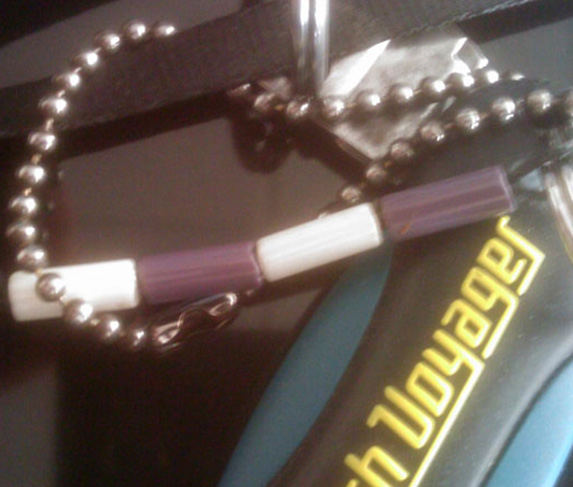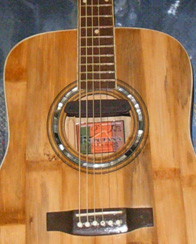The Making of Wampum
Marc Frucht
Anth 3451
Final Paper about Final Presentation.
December, 2009
I chose to learn how difficult it is to make wampum beads by hand in an effort to understand why people who make contemporary wampum jewelry seldom also make wampum beads.
It turns out that even the most skilled artisans can only make one complete bead after about 20 minutes of difficult and dangerous work. Power tools do not cut this time down very much because for every minute you might gain in technology, you lose just as much, if not more to broken shells. If you see beads such as these (and they are not antique:)
there is a high likelihood they will be plastic, glass or wood, but not shell. To be honest, the last technological innovation that has helped streamline the construction of wampum beads was the steel drill. As I’d said before, if you try taking the next step and electrify that drill you must be very careful to use the slowest setting; still you must bear down ever so lightly or a shell will break unexpectedly, wasting all the time you’d put in making that bead.
After I got the hang of drilling my beads, I tried using a Dremel tool at its slowest setting and I never had good results no matter how I would change my technique. I’d get 2/3 of the way into a bead or so, and it would smash, or crack.
Quahogs that people work with traditionally are about 5 inches long and 2 1/2 inches wide, with a very thick shell. It’s rare that you find quahog shells that large nowadays. After this project I learned that Quahogs are much smaller nowadays because just like Cod and Lobsters, they’ve been fished out the past couple hundred years. So the ones that are found in southern New England aren’t very large, and don’t have a very thick purple part. Often times you’re only able to make a bead that is short and narrow which wouldn’t be useful for too many other projects.
I did most of my breaking and cutting on the rocks at Avery Point’s shore in Groton, CT. Then I did most of the drilling and grinding on a picnic table in my back yard on the other side of Groton. Half way through the process on several beads, I learned that it’s best to do all of the work under the water because the dust that comes away from your product is toxic. Since my project was during early winter months, I didn’t have much choice so I kept a bowl of water near and dunked the pieces regularly, and took lots of breaks, but I wasn’t able to do all the work under the water.
I broke the first couple shells into pieces that were much too small. I found I was using a large stone and bearing down with all my might, when I didn’t need to. If you just tap lightly 2-3 times, they will break into something close to uniform rectangular pieces. Not ever piece is usable of course; but if you’re starting from a very large shell (all but one of my Quahog shells were too small to be honest) you’ll get 5 or 6 pieces that might become a bead with the traditional sizes of 8mm in length and 5mm in diameter or perhaps 7mm by 5mm.
There was a seagull who was watching me work for a very long time during one of my project sessions. You’ll see him or her in the video I presented.
http://www.tinyurl.com/MakingWampum
In picking music for the soundtrack I decided I’d only use instrumental guitar and mostly old standards such as ‘Summertime’ from Porgy and Bess, and ‘Rebel Rouser’ by Duane Eddy. I used the melody to ‘Limbo Rock’ trying to give motion to the segment where the bird was flying across the water, but I also noticed it worked well while s/he was walking around on the rocks as well.
I insisted on using guitars that I’ve adopted and reworked by hand to in an effort to match the energy of the project itself. So the two guitars I picked are a bamboo guitar that a friend gave me because he thought it was really ugly. After accepting it, I learned that it was handmade by a guy named Jun Reputana who is a famous luthier near Ceba Philippines. Instead of mother of pearl inlay, he uses shell that he finds on the shore where he lives. It turns out he walks up and down the beach until he’s found just the right shell to go along with the guitar he’s making!
The second guitar I picked was a ’74 Castilla Strat copy, I found in a Goodwill and had my friend Zack in Westerly, RI. do all the extra recondition that I’m not good at. That’s the one I used for the stereotypical NDN sounds that I began the video with as a somewhat comedic ice-breaker.
I’m told the word ‘Quahog’ comes from the Narraganset word Poquauhock and that the Algonquin word Wampumpeag is white shell. No one seems to know what meant purple or black shell; but I have a hunch it’s going to be something like Wampumpog or maybe Wampumpaug. I chose to not include all of that in my presentation because I didn’t want to include hunches. I’ll keep researching and hope I bump into those meanings as well.
I didn’t finish the final two beads I presented on. Some of why I stopped right there was that I was running out of time; but I also recognized that I had enough to present on at that point. And perhaps showing what I wasn’t able to complete has more meaning than if I had in fact come up with my original goal of four beads, two perfectly purple, and two wonderfully white. I managed to drill all the way through one shell and had begun smoothing the cylinder down a little bit more narrow, and I was almost all the way to the other side of the second one when I noticed since I was too close to one of the sides, I’ll have the problem as I narrow that one, that I’ll run out of fiber that can be taken down. So that one is most likely going to crack, leaving me with only the one nearly finished bead.
I never worked with any Atlantic Whelk, because I wasn’t able to find any from restaurants; and no one had a lead on who else I could ask. But I learned that whelk shells give the best texture for a snowy white bead to complement with the all purple ones. I can find whelk meat in Chinese groceries, but not the shell. I’d love to find out someday where it is they dispose of their shells.
Sources Cited:
http://www.nativetech.org/wampum/wamphist.htm
http://www.peace4turtleisland.org/pages/wampum1.htm
http://www.associatedcontent.com/article/672397/how_to_make_your_own_wampum_beads.html
http://www.ehow.com/how_5172118_make-wampum-beads.html
http://xingyangaquatics.en.made-in-china.com/product/IbNmPSTUqAYR/China-Whelk-Meat-Slices-4-.html
Brennessel, Barbara. Good Tidings: The History and Ecology of Shellfish Farming in the Northeast. Lebanon: University Press of New England, 2008.
SEE THIS PAPER AS A WORD DOC:
http://www.frucht.org/framesbymarco/ThemakingofWampum.doc
Lastly here are a couple shameless plugs, just because this page ended up higher in google and bing for some reason. Â 😉


